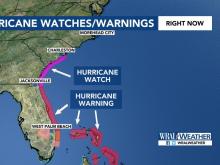- Is your neighborhood at high wildfire risk? | Here's how to check the city's wildfire risk map
- 'Be prepared now': Brad Panovich updates severe weather risk for Sunday
- 'Be prepared now': Brad Panovich updates severe weather risk for Sunday
- As anxiety around wildfires grows, Austin plans to add tens of thousands of acres to risk map
- 'Not enough firefighters' | Rural fire departments in Central Texas get boost to help them fight wildfires
Are you ready for Hurricane Dorian? Here's how to prepare

Cary, N.C. — From Florida up to the North Carolina coast, mandatory evacuations are in place as officials warn everyone to take Hurricane Dorian seriously. As people along the coast prepare, here are some ways you can get ready for the storm, too.
Experts suggest people who may be impacted by the storm take the following precautions:
- List out personal property
- Review insurance policies
- Check flooding maps
- Turn off main power in case of flooding
- Bring bulky items inside
- Cover windows doors
- Put sandbags in place
Three-day supply kit
Start with an easy to carry, watertight container – a large, plastic trash can will do, or you can line a sturdy cardboard box with a couple of trash bags. Next, gather the following items and place them in your kit:
Water: 1 gallon per person per day. Fill plastic containers, such as soft-drink bottles.
Water purification kit or bleach (use eight drops of regular bleach per gallon of water.)
Essential medications
First-aid book and kit that includes:
- 20 emergency bandages of various sizes
- One 5 x 9 sterile dressing
- One roll of self-adhering elastic bandage
- Four various-sized sterile gauze pads
- One roll of 3-inch cohesive bandage
- Waterless alcohol-based sanitizer and wipes
- Medical grade non-latex gloves
- Adhesive tape, 2-inch width
- Anti-bacterial ointment
- Cold pack
- Small scissors
- Tweezers
- CPR breathing barrier, such as a face shield
- Non-prescription drugs (e.g., aspirin or non-aspirin pain relievers)
Ready-to-eat, non-perishable foods, such as canned meats, granola bars, instant soup and cereals, fruits and vegetables, canned or box juices, peanut butter, jelly, crackers, granola bars, trail mix, bread and any special dietary items you and your family need.
Manual can opener
Baby supplies: formula, bottle, pacifier, soap, baby powder, clothing, blankets, baby wipes, disposable diapers, canned food and juices
Food, water, leash and carrier for pets (If you plan to go to a shelter, remember that most do not allow pets. Make other plans for your pets.)
Sanitary items:
- Large, plastic trash bags for waste and to use as tarps and rain ponchos
- Large trash cans
- Towelettes
- Bar soap and liquid detergent
- Shampoo
- Toothpaste and toothbrushes
- Feminine hygiene supplies
- Toilet paper
- Household bleach for cleaning
- Rubber gloves
Blanket or sleeping bag per person
Battery-powered, portable radio or portable TV and plenty of extra batteries
Flashlight and extra batteries
Extra pair of eyeglasses
Extra house and car keys
Fire extinguisher (ABC-type)
Cash and change
Seasonal change of clothing, including sturdy shoes
Prepare your paperwork
Start with a portable, waterproof (airtight) bag that’s brightly colored, so you can quickly find it in the dark. Diving equipment shops stock the ideal bag, but gallon-sized or larger zip-lock bags will do in a pinch.
Print this checklist and keep it inside your waterproof bag to help you collect the items listed below:
- Driver’s license, photo ID
- Emergency contact list or address book (even if contacts are stored in a smartphone)
- Insurance policies (health, home, auto)
- Vital documents (birth certificates, passports, wills)
- Bank account information (account numbers, passwords)
- Photocopies of credit and debit cards (front and back)
- Stock certificates, investment information
- Extra keys (home, safe deposit box, office and car)
Remember: When packing, be realistic about what you can carry. Pack only what is essential for surviving the storm and its aftermath.